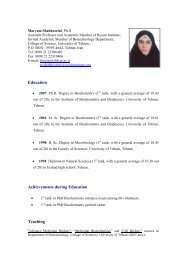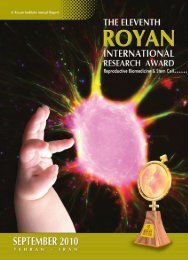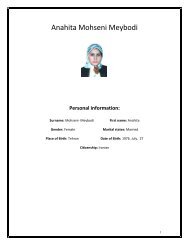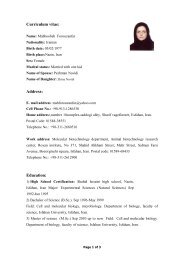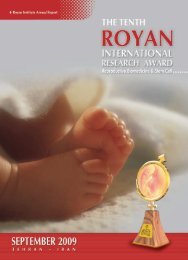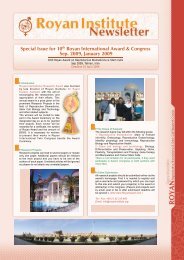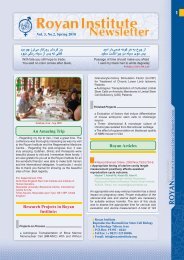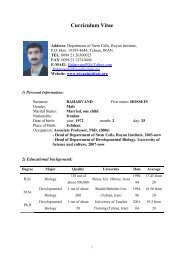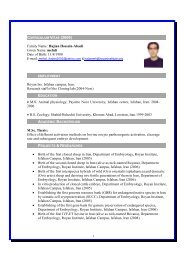Vol 1. No 2. Spring 2008 - Royan Institute
Vol 1. No 2. Spring 2008 - Royan Institute
Vol 1. No 2. Spring 2008 - Royan Institute
Create successful ePaper yourself
Turn your PDF publications into a flip-book with our unique Google optimized e-Paper software.
1<br />
<strong>Vol</strong>. 1, <strong>No</strong>. 2, <strong>Spring</strong> <strong>2008</strong><br />
The only vision I have is your sight<br />
The only thing I follow is your light.<br />
Everyone finds his repose in sleep,<br />
Sleep from my eyes has taken flight.<br />
Hafiz-e Shirazi (1310-1388)<br />
جز نقش تو در نظر نيامد ما را<br />
جز كوى تو رهگذر نيامد ما را<br />
خواب ارچه خوش آمد همه را در عهدت<br />
حقا كه به چشم در نيامد ما را<br />
حافظ شيرازي<br />
Research Projects in <strong>Royan</strong><br />
<strong>Institute</strong>:<br />
Projects on Process:<br />
1- Differentiation of stem cells to neural cells and<br />
transplantation to rat model of spinal cord injury<br />
2- The effect of low dose HCG on folliculogenesis of<br />
PCO patients undergoing ART<br />
Finished Projects:<br />
1- Culture and proliferation of human limbal stem<br />
cells<br />
2- Effect of phosphodiesterase on in-vitro maturation<br />
and development of immature mouse oocytes<br />
Ethics Symposium – Winter of <strong>2008</strong><br />
Ethical concerns related to embryo donation were<br />
discussed in an one-day symposium, entitled “Embryo<br />
Donation from an Ethical Point of View”, that was held<br />
at the <strong>Royan</strong> <strong>Institute</strong> on 3rd Jan <strong>2008</strong>. The aim of<br />
this symposium was to discuss a recently passed law<br />
about permission for embryo donation in Iran and to<br />
consider ethical, moral, legal, religious, psychological,<br />
and social views. The symposium lasted 9 hours<br />
and consisted of three sessions held in six panels: 1)<br />
medical and health; 2) psychological; 3) religious; 4)<br />
legal; 5) social; and 6) moral and ethical.<br />
More than 300 scientists and doctors participated in<br />
the symposium and active discussion and question<br />
and answers were the main part of the symposium.<br />
Medical doctors, clergy leaders, law experts,<br />
socialists and psychologists were participated in all<br />
the discussions and this symposium managed to<br />
a declaration. This declaration was sent to all the<br />
infertility centers, hospitals, Iran’s parliament, religious<br />
research centers and medical faculties faculties. “We<br />
hope that the pitfalls of the Embryo donation law will<br />
be corrected in the future” said the chairman of the<br />
symposium, Seyed Taha Merghati. “We try to discuss<br />
about the problem before they make difficult situation<br />
that we cannot control”. The symposium was closed<br />
by the chairman of the health and medical committee<br />
of Iran’s parliament.<br />
AN AMAZING TRIP<br />
By: ELZA MARIA PRESTES SARTORELLI, PhD in Human<br />
Genetics<br />
I was invited to go to Iran to<br />
present my PhD research<br />
at the <strong>Royan</strong> <strong>Institute</strong><br />
Congress, as a poster, in<br />
200<strong>2.</strong><br />
At the Congress, besides<br />
meeting many distinguished<br />
scientists from all over the<br />
world, I had the pleasure<br />
of taking a course on<br />
techniques of assisted<br />
reproduction with Iranian<br />
doctors’ experts. The way<br />
they were developing their<br />
work at The <strong>Royan</strong> <strong>Institute</strong><br />
made me realize that they were using the most top<br />
techniques on human infertility there.<br />
The whole team from The <strong>Royan</strong> <strong>Institute</strong> welcomed<br />
us in a very special way, trying to show us a bit from<br />
their culture and their way of living.<br />
After all the splendid time we spent in Teheran, we<br />
had the great opportunity of traveling to Shiraz and<br />
Esfahan, a tour guided by a special member from<br />
<strong>Royan</strong> <strong>Institute</strong>.<br />
The chance I had in 2002 was an unexpected<br />
happening and a pleasant surprise in my life.<br />
ELZA MARIA PRESTES SARTORELLI, PhD in Human<br />
Genetics<br />
Department of Cellular Biology, Embryology and Genetics<br />
Center of Biological Sciences<br />
University of Santa Catarina, Brazil<br />
<strong>Royan</strong> <strong>Institute</strong><br />
Reproductive Biomedicine Stem Cell Biology<br />
& Technology Tehran, Iran<br />
P.O.Box: 19395 - 4644<br />
Tel/Fax: (+9821) 22310406<br />
E-mail: info@royaninstitute.org
<strong>Royan</strong> Articles<br />
Int J Androl. 2007 Oct 30<br />
Varicocelectomy: semen parameters and<br />
protamine deficiency.<br />
Nasr-Esfahani MH, Abasi H, Razavi S, Ashrafi<br />
S, Tavalaee M.<br />
Department of Embryology and Andrology, <strong>Royan</strong><br />
<strong>Institute</strong>, Tehran, Iran.<br />
Different methods have been used to evaluate the<br />
beneficial effect of varicocelectomy; these include<br />
semen parameters and pregnancy rate. Because<br />
of high biological variability of semen parameters,<br />
sperm functional tests have been considered as an<br />
efficient end point in assessment of fertility. Therefore,<br />
the aim of this study was to evaluate the effect of<br />
varicocelectomy on semen parameters and sperm<br />
protamine deficiency in 192 patients. The results<br />
of the present study show that all the three semen<br />
parameters and percentage of sperms with normal<br />
protamine content have improved post-surgery. The<br />
cumulative pregnancy rate was 34.6%. Comparing the<br />
results of the semen parameters and protamine content<br />
between patients whose partner became pregnant to<br />
those who did not benefit from varicocelectomy before<br />
and 6 months after surgery, show that patients may<br />
benefit from varicocelectomy that had higher initial<br />
semen density and better sperm morphology prior<br />
to surgery. Detailed analyses of sperm morphology,<br />
along with aforementioned results reveal that the<br />
factors which account for pregnancy difference are:<br />
(i) improvement in early events of spermatogenesis,<br />
possibly during spermatocytogensis and reduction<br />
division; and (ii) late spermiogenesis events. Thus, it<br />
can be suggested that patients with low initial sperm<br />
count may benefit more from assisted reproductive<br />
techniques or varicocelectomy followed by assisted<br />
reproduction.<br />
Cell Biol Int. 2007 Oct 7<br />
Differential effect of activin on mouse<br />
embryonic stem cell differentiation in insulinsecreting<br />
cells under nestin-positive selection<br />
and spontaneous differentiation protocols.<br />
Jafary H, Larijani B, Farrokhi A, Pirouz M,<br />
Mollamohammadi S, Baharvand H.<br />
Department of Stem Cells, <strong>Royan</strong> <strong>Institute</strong>, P.O. Box<br />
19395-4644, Tehran, Iran.<br />
DParallel to the importance of the development of<br />
cell therapies to treat diabetes is the production of<br />
sufficient numbers of pancreatic endocrine cells that<br />
function like primary islets. To increase the efficiency<br />
of endocrine pancreatic-like cell differentiation from<br />
mouse embryonic stem cells (ESCs), we applied<br />
activin-B to nestin-positive selection (protocol 1) and<br />
spontaneous differentiation (protocol 2) in different<br />
groups including: [A] activin-B, or [B] basic fibroblast<br />
growth factor (bFGF), and/or [C] activin-B+bFGF. The<br />
differentiated cells expressed most pancreatic-related<br />
genes. The number of insulin- and C peptide-positive<br />
cells, as well as dithizone-positive clusters in group<br />
A of protocol 1 was higher than in the other groups.<br />
Significant insulin concentrations in protocol 1 were<br />
produced when glucose was added to the medium, in<br />
comparison with protocol <strong>2.</strong> Moreover, insulin release<br />
was increased significantly in group A of protocol 1 even<br />
with lower glucose. In conclusion, Addition of activin-B<br />
in a nestin-positive selection protocol increased the<br />
insulin-secreting cells in comparison with the same<br />
protocol with bFGF and/or spontaneous differentiation<br />
in presence of bFGF and/or activin-B alone. However,<br />
improvements of the current method are required to<br />
generate a sufficient source of true beta-cells for the<br />
treatment of diabetes mellitus.<br />
Fertil Steril. <strong>2008</strong> Jan 16<br />
Artificial oocyte activation in severe<br />
teratozoospermia undergoing<br />
intracytoplasmic sperm injection.<br />
Nasr-Esfahani MH, Razavi S, Javdan Z, Tavalaee<br />
M.<br />
Department of Embryology and Andrology, <strong>Royan</strong><br />
<strong>Institute</strong>, Tehran, Iran; Isfahan Fertility and Infertility<br />
Center, Isfahan, Iran.<br />
OBJECTIVE: To evaluate efficiency of Ionomycin on<br />
fertilization and cleavage rates, embryo development,<br />
and pregnancy rate after intracytoplasmic sperm<br />
injection (ICSI) in teratozoospermic patients. DESIGN:<br />
Laboratory study. SETTING: Isfahan fertility and<br />
infertility Center, and <strong>Royan</strong> institute, Tehran, Iran.<br />
PATIENT(S): Eighty-seven couples with male factor<br />
etiology (severe teratozoospermia) undergoing ICSI.<br />
INTERVENTION(S): Ionomycin for artificial oocyte<br />
activation.<br />
MAIN OUTCOME MEASURE(S): After oocyte<br />
collection, the oocytes were randomly divided into<br />
two groups: control and artificial oocyte activation<br />
(AOA). The injected oocytes in the control group were<br />
cultured in G<strong>1.</strong> The remaining oocytes were chemically<br />
activated by exposure to 10 muM Ionomycin for 10<br />
minutes. Around 16 to 18 hours after ICSI, fertilization<br />
was assessed by the presence of pronuclei. The<br />
percentage of cleavage and high-quality embryos<br />
were calculated 48 and 72 hours after ICSI. Clinical<br />
pregnancy also was determined based on ultrasound<br />
observation of a fetal heart beat. RESULT(S): There<br />
are significant differences in the mean of fertilization<br />
and cleavage rates 72 hours after ICSI between AOA<br />
and control groups. In patients who had no fertilization<br />
in the control group and all the embryos for transfer<br />
derived from the AOA group, two pregnancies were<br />
recorded. In the patients who had poor fertilization rate<br />
(1%-33%) in the control group (14.30%), there was a<br />
significant increase in mean fertilization rate (58.31%)<br />
because of AOA. The results of the present study also<br />
reveal that the samples had motile sperm, whereas in<br />
the chemically activated group this difference was not<br />
significant. CONCLUSION (S): It can be concluded<br />
that in cases with severe teratozoospermia AOA may<br />
improve fertilization and cleavage rates, which in turn,<br />
affect the implantation and pregnancy rate.<br />
2
Science Reference<br />
Somatic cell<br />
EA somatic cell is generally taken to mean any cell<br />
forming the body of an organism.<br />
Somatic cells, by definition, are not germline cells.<br />
In mammals, germline cells are the sperm and ova (also<br />
known as “gametes”) which fuse during fertilization to<br />
produce a cell called a zygote, from which the entire<br />
mammalian embryo develops.<br />
Every other cell type in the mammalian body, apart<br />
from the sperm and ova, the cells from which they are<br />
made (gametocytes) and undifferentiated stem cells,<br />
is a somatic cell; internal organs skin, bones, blood<br />
and connective tissue are all made up of somatic<br />
cells.. For more information about the topic Somatic<br />
cell, read the full article at Wikipedia.org ,<br />
Reference: http://www.sciencedaily.com/articles/s/<br />
somatic_cell.htm<br />
Methods in Human<br />
Embryonic Stem Cell Research<br />
October 15, <strong>2008</strong> - October 18, <strong>2008</strong><br />
Bar Harbor, ME, United States<br />
nations in the world present more of a justification for<br />
the study of history than Iran.”<br />
The arrival of the Iranian peoples begins in the early<br />
first millennium BC, and the establishing of the Median<br />
dynasty (728–550 BC) culminated in the first Iranian<br />
Empire. The Medes are credited with the foundation<br />
of Iran as a nation and empire, and established the<br />
first Iranian empire, the largest of its day until Cyrus<br />
the Great established a unified empire of the Medes<br />
and Persians leading to the Achaemenian Empire<br />
(648–330 BC).<br />
Cyrus the Great created the Cyrus Cylinder, considered to<br />
be the first declaration of human rights. He was the first king<br />
whose name has the suffix "Great" and the first Shah of Iran<br />
to be known by that title. Cyrus also banned slavery in all<br />
of the conquered areas that became the Persian Empire.<br />
Cyrus' seminal ideas greatly influenced later human<br />
civilizations; Cyrus' principles of ruling – advocating "love"<br />
rather than "fear"<br />
3<br />
18th World<br />
Congress on Ultrasound in<br />
Obstetrics and Gynecology<br />
August 24, <strong>2008</strong> - August 28, <strong>2008</strong><br />
Chicago, IL, United States<br />
A Short History about<br />
IRAN<br />
Early history and the Median and<br />
Achaemenian Empires (900 BC – 330 BC)<br />
The role of Iran in history is highly significant; hence<br />
the German philosopher Georg Wilhelm Friedrich<br />
Hegel considered the ancient Persians to be “the first<br />
historic people” and stated thus:<br />
“In Persia first arises that light which shines itself<br />
and illuminates what is around...The principle of<br />
development begins with the history of Persia; this<br />
constitutes therefore the beginning of history”. “Few<br />
I am Kourosh (Cyrus), King of the world, great<br />
king, mighty king, king of Babylon, king of the land<br />
of Sumer and Akkad, king of the four quarters, son<br />
of Camboujiyah (Cambyases), great king, king of<br />
Anshân, grandson of Kourosh (Cyrus), great king,<br />
king of Anshân, ...<br />
… <strong>No</strong>w that I put the crown of kingdom of Iran,<br />
Babylon, and the nations of the four directions on the<br />
head with the help of (Ahura) Mazda, I announce that I<br />
will respect the traditions, customs and religions of the<br />
nations of my empire and never let any of my governors<br />
and subordinates look down on or insult them until I<br />
am alive. From now on, till (Ahura) Mazda grants me<br />
the kingdom favor, I will impose my monarchy on no<br />
nation. Each is free to accept it, and if any one of them<br />
rejects it, I never resolve on war to reign. Until I am<br />
the king of Iran, Babylon, and the nations of the four<br />
directions, I never let anyone oppress any others, and<br />
if it occurs, I will take his or her right back and penalize<br />
the oppressor...<br />
http://en.wikipedia.org/wiki/History_of_Iran<br />
& http://www.iranchamber.com/history/cyrus/cyrus_<br />
charter.php
Science News<br />
Science News<br />
4<br />
Blood Stem Cells Originate And Are Nurtured In<br />
The Placenta<br />
ScienceDaily (Mar. 6, <strong>2008</strong>)<br />
Solving a long-standing biological mystery, UCLA<br />
stem cell researchers have discovered that blood<br />
stem cells, the cells that later differentiate into all the<br />
cells in the blood supply, originate and are nurtured in<br />
the placenta.<br />
The discovery may allow researchers to mimic the<br />
specific embryonic microenvironment necessary for<br />
development of blood stem cells in cell culture and<br />
grow them for use in treating diseases like leukemia<br />
and aplastic anemia, said Dr. Hanna Mikkola, a<br />
researcher in the Eli and Edythe Broad Center of<br />
Regenerative Medicine and Stem Cell Research and<br />
senior author of the study.<br />
“It was a big mystery, where these cells originated,”<br />
said Mikkola, an assistant professor of molecular,<br />
cell and developmental biology. “This is the first<br />
time we can really say definitively that blood stem<br />
cells are generated in the placenta. There’s no more<br />
speculation.”<br />
The study published March 6, <strong>2008</strong> in the journal Cell<br />
Stem Cell. Researchers in Mikkola’s lab are working<br />
now to replicate this work, done in mouse models, in<br />
humans.<br />
If researchers could grow blood stem cells, those cells<br />
could be transplanted into these patients. The blood<br />
stem cells would then differentiate into a new, and<br />
healthy, blood supply. And with the recent success<br />
in creating induced pluripotent stem cells (iPS) from<br />
human skin cells, a patient’s own skin cells could<br />
perhaps be used to create iPS cells. Those cells could<br />
then be transformed into blood stem cells, creating<br />
an immune-compatible source of blood supply that<br />
eliminates the risk of graft vs. host disease.<br />
In her previous research, Mikkola and collaborators in<br />
Harvard and France had discovered that the placenta<br />
contained a large pool of blood stem cells, but it wasn’t<br />
clear if they originated elsewhere and migrated to the<br />
placenta to self-renew. Using a unique mouse model,<br />
a mouse embryo without a heartbeat, Mikkola and<br />
her team were able to find the blood stem cells at the<br />
site of their origin because there was no circulation of<br />
blood through the body.<br />
“Using this model, we identified that the placenta has<br />
the potential to make hematopoietic (blood) stem cells<br />
with full differentiation ability to create all the major<br />
lineages of blood cells,” Mikkola said. “The placenta<br />
acts as a sort of kindergarten for these newly made<br />
blood stem cells, giving them the first education they<br />
need.”<br />
“The labyrinth is a source of many growth factors and<br />
cytokines,” Mikkola said. “We just need to identify<br />
what those signaling molecules and cues are that are<br />
nurturing those cells when in the placenta.”<br />
Mikkola is confident the study can be confirmed in<br />
humans. “Everything we’re learning suggests we will<br />
find the same thing in the human placenta,” she said.<br />
See more: http://www.sciencedaily.com/<br />
releases/<strong>2008</strong>/03/080305121006.htm<br />
Significantly Higher Success Rates with Artificial<br />
Insemination Using New Ova Assessment Tool<br />
ScienceDaily (Feb. 12, <strong>2008</strong>)<br />
Trying to conceive with fertility technology? A new<br />
method could help some couples who are childless<br />
against their will. The microscopic procedure<br />
significantly improves the success rate of ‘ICSI’<br />
(intracytoplasmic sperm injection). This was discovered<br />
by scientists at the University of Bonn together with<br />
colleagues from China and industrial partners in a<br />
study of 124 women. Up to now, the desire to have a<br />
child is only fulfilled for every third couple that decides<br />
to have ICSI. In a study the artificial insemination<br />
method was twice as successful.<br />
For many couples ICSI is the last resort in their<br />
attempt to have a child. ‘The method is recommended<br />
if the man produces too few sperm cells,’ the Bonn<br />
reproductive biologist Dr. Markus Montag explains.<br />
Doctors can in most cases still extract individual<br />
functioning sperm cells from testicular tissue, which<br />
they then inject into the ovum. The partner must take<br />
hormone preparations before an ICSI. They result in<br />
several ova maturing in the ovaries, normally it is only<br />
one ovum per month.<br />
‘We inject a sperm into every one of these cells,’<br />
Markus Montag explains. ‘Then it takes more than 26<br />
hours until the plasmosomes of the ovum and sperm<br />
cell fuse and an embryo forms. In this time frame we<br />
have to decide which of the fertilized ova to insert into<br />
the uterus.’ The reason for this is that the German<br />
law for the protection of embryos lays down that only<br />
a maximum of three fertilised ova are allowed to be<br />
implanted per attempt. ‘We even restrict ourselves to<br />
only two, in order to exclude the possibility of births of<br />
triplets,’ Markus Montag explains. With pregnancies<br />
involving multiple births there is an increased risk of<br />
miscarriages and malformations.<br />
Choosing the ‘best’ ova<br />
Which of the fertilized ova are finally implanted has<br />
usually been left up to chance. But today it is known<br />
that not all ova have the same quality. Using a special<br />
procedure the Bonn scientists can select the two most<br />
suitable candidates. ‘For this we observe the ovule<br />
integument under a DIC microscope,’ Dr. Montag<br />
explains. ‘There it appears as a luminescent orangered<br />
ring. The brighter this ring is and the more uniformly<br />
it shines, the greater the chance that it becomes a<br />
child.’ The reason for this is that the ovule integument<br />
always seems to have a particularly uniform structure<br />
if the cell has matured under good conditions.<br />
<strong>No</strong>rmally every third ICSI is successful. But if medics<br />
used two ‘good ‘ ova in their experiment, this rate<br />
increased to more than 50 per cent. With a ‘good’<br />
and a ‘bad’ ovum the success rate was still around<br />
40 per cent, using two ‘bad’ ones only 20 per cent.<br />
‘Mind you, two “good” ova are rare,’ Markus Montag<br />
emphasises. ‘Only with two out of ten cells does the<br />
ovule integument have an intense regular orange<br />
color.’<br />
Under natural conditions insemination takes place in<br />
the oviduct. After that the ovum begins to divide, while<br />
contractions of the oviduct transport it to the uterus.
This process takes just under 2-3 days. When the<br />
embryo lodges in the endometrium on the sixth day<br />
after insemination, the embryo consists of several<br />
hundred cells. During the whole process the embryo<br />
is protected by the ovule integument.<br />
The Bonn team led by Dr. Markus Montag and<br />
Professor Hans van der Ven has developed software<br />
in conjunction with the Octax Microscience Company,<br />
which analyses the image from the microscope<br />
objectively and proposes the most suitable cells. ‘This<br />
way the procedure can be implemented in clinical<br />
routine without problems and without much effort,’ he<br />
says.<br />
The scientists have now published their data in the<br />
journal ‘Reproductive BioMedicine Online ‘. version<br />
available at: http://www.rbmonline.com/Article/3161<br />
Reference: http://www.sciencedaily.com/<br />
releases/<strong>2008</strong>/02/08020610241<strong>2.</strong>htm<br />
9 th<br />
<strong>Royan</strong><br />
International Research Award<br />
Aug 27 – 29, <strong>2008</strong><br />
Reproductive Biomedicine & Stem Cells<br />
Biology & Technology<br />
Deadline 10 April <strong>2008</strong><br />
E-mail: Info@<strong>Royan</strong><strong>Institute</strong>.org<br />
AGOS <strong>2008</strong><br />
American Gynecological and Obstetrical<br />
Society<br />
10-20 Sep., <strong>2008</strong><br />
Carlsbad, CA, USA<br />
<strong>Royan</strong><br />
International Twin<br />
Congress<br />
9th Congress on Reproductive<br />
Biomedicine<br />
4th Congress on Stem Cells Biology &<br />
Technology<br />
Aug 27-29, <strong>2008</strong> - Tehran - Iran<br />
In Collaboration With: European Society<br />
of Human Reproduction and Embryology<br />
(ESHRE)<br />
Middle East Fertility Society (MEFS)<br />
British Andrology Society (BAS)<br />
Asia Reproductive<br />
Biotechnology Society<br />
(ARBS)<br />
5<br />
We will glad to see you in our Congress<br />
27-29 Aug <strong>2008</strong>, Tehran - IRAN<br />
Please Smile,,,<br />
If you want to have our newsletter for your<br />
friend, let us know by<br />
Info@<strong>Royan</strong><strong>Institute</strong>.org<br />
Fertility Society of Australia - Annual<br />
Meeting <strong>2008</strong> 20 – 22 Oct., <strong>2008</strong><br />
Location: Brisbane, Australia



